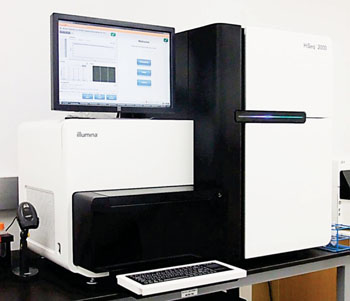Early Gene Changes Identified That Precede Blood Cancer
By LabMedica International staff writers
Posted on 16 Dec 2014
DNA samples have been used to uncover early, precancerous genetic changes in the blood that are linked to increased chances of developing blood cancers such as leukemia, lymphoma or myelodysplastic syndrome.Posted on 16 Dec 2014
The development of disease often involves dynamic processes that begin years or decades before the clinical onset and in many cases the process of pathogenesis goes undetected until after the patient has symptoms and presents with clinically apparent disease.

Image: The HiSeq 2000 sequencing platform (Photo courtesy of Illumina).
A large team of scientists led by those at Harvard Medical School (Boston, MA, USA) obtained blood samples for DNA sequencing from 12,380 Swedish persons whose mean age at time of sample collection was 55 years. The cohort included 6,245 controls, 4,970 persons with schizophrenia, and 1,165 persons with bipolar disorder. DNA was extracted directly from peripheral venous blood samples.
The initial sequencing was carried out using the genome analyzer GAII (Illumina; San Diego, CA, USA) instruments and the remaining specimens were sequenced using Illumina’s HiSeq 2000 and HiSeq 2500 instruments, with pair ended sequencing reads of 76 base pairs across all specimens. Sequencing was performed at the Broad Institute (Cambridge, MA, USA) and Harvard across the period of time from 2010 to 2013.
The team found that a subset, some, but not all, of mutations known to feature in blood cancers were present in individuals who were 10 times more likely to develop blood cancer later in life, compared with individuals who did not have these mutations. This cluster of pre-cancerous mutations, which was easily detected by DNA sequencing, is rarely found in the blood of people under the age of 40. It becomes more common with age and appears in more than 10% of people over the age of 70. Most of the mutations occurred in just three genes: DNA (cytosine-5)-methyltransferase 3A (DNMT3A), tet methylcytosine dioxygenase 2 (TET2) and, additional sex combs like transcriptional regulator 1 (ASXL1).
Steven A. McCarroll, PhD, an assistant professor of genetics and a senior author of the study said, “The results demonstrate a way to identify high-risk cohorts, people who are at much higher than average risk of progressing to cancer, which could be a population for clinical trials of future prevention strategies. The abundance of these mutated cells could also serve as a biomarker to test the effects of potential prevention therapies in clinical trials.” The study was published on November 26, 2014, in the New England Journal of Medicine (NEJM).
Related Links:
Harvard Medical School
Illumina
Broad Institute













